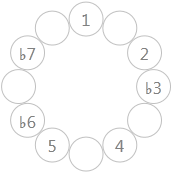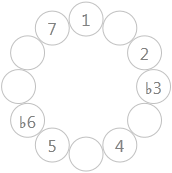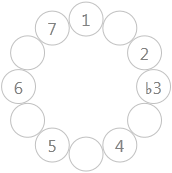

19.1. The heptatonic natural minor scale formula is essentially the major scale formula rotated so that 6 (the submediant) of the major becomes 1 (the tonic) of the minor. So the natural minor scale formula can be defined as the sequence of intervals maj2, min2, maj2, maj2, min2, maj2. A maj2 completes the octave.
19.2. The following diagram shows the scale degrees of the natural minor scale formula. Relative to the major scale formula, the natural minor scale formula has flatted 3rd, 6th and 7th degrees.
19.3. The degrees of this formula are denoted relative to the degrees of the major scale formula. The natural minor scale formula is 1 2 b3 4 5 b6 b7, and it is pronounced "one two flat-three [...] flat-seven".

19.4. The technical names of the degrees in the natural minor scale formula are: tonic (the first degree, 1), supertonic (the second degree, 2), mediant (the third degree, b3), subdominant (the fourth degree, 4), dominant (the fifth degree, 5), submediant (the sixth degree, b6), and subtonic (the seventh degree, b7). Notice that the seventh degree is not a leading-tone because it is b7 and not 7.
19.5. The following table shows the intervals from the tonic to each of the degrees.
| 1 (tonic) up to… | |
|---|---|
| 2 (supertonic) | maj2 |
| b3 (mediant) | min3 |
| 4 (subdominant) | per4 |
| 5 (dominant) | per5 |
| b6 (submediant) | min6 |
| b7 (subtonic) | min7 |
Take the Intervals between degrees in the natural minor scale formula test.
20.1. The heptatonic harmonic minor scale formula is essentially the natural minor with the flatted seventh degree (the subtonic) restored to the natural seventh degree of the major scale formula (the leading-tone). As will be seen later, this makes the harmonic minor more useful for harmonizing, hence its name. The harmonic minor scale class can be defined as the sequence of intervals maj2, min2, maj2, maj2, min2, aug2. A min2 completes the octave.
20.2. The following diagram shows the scale degrees of the harmonic minor scale formula. Relative to the major scale formula, the harmonic minor scale formula has flatted 3rd and 6th degrees.
20.3. The degrees of this formula are denoted relative to the degrees of the major scale formula. The natural minor scale formula is 1 2 b3 4 5 b6 7, and it is pronounced "one two flat-three [...] seven".

20.4. The technical names of the degrees in the harmonic minor scale formula are: tonic (the first degree, 1), supertonic (the second degree, 2), mediant (the third degree, b3), subdominant (the fourth degree, 4), dominant (the fifth degree, 5), submediant (the sixth degree, b6), and leading-tone (the seventh degree, 7).
20.5. The following table shows the intervals from the tonic to each of the degrees.
| 1 (tonic) up to… | |
|---|---|
| 2 (supertonic) | maj2 |
| b3 (mediant) | min3 |
| 4 (subdominant) | per4 |
| 5 (dominant) | per5 |
| b6 (submediant) | min6 |
| 7 (leading-tone) | maj7 |
Take the Intervals between degrees in the harmonic minor scale formula test.
21.1. The heptatonic melodic minor scale formula is an interesting anomaly because it has different ascending and descending forms. It eliminates the awkward augmented second of the harmonic minor and serves as a framework on which minor-mode melodies can be written that are easy to sing, hence its name. Ascending, the melodic minor is essentially the harmonic minor with the flatted sixth degree restored to the natural sixth degree of the major scale formula. The melodic minor scale formula ascending can be defined as the sequence of intervals maj2, min2, maj2, maj2, maj2, maj2. A min2 completes the octave. Descending, the flatted sixth and seventh degrees of the natural minor scale are restored.
21.2. The following diagram shows the scale degrees of the ascending melodic minor scale formula. Relative to the major scale formula, the ascending natural minor scale formula has a flatted 3rd degree.
21.3. The degrees of this formula are denoted relative to the degrees of the major scale formula. The melodic minor scale formula, combining both its ascending and descending forms, is 1 2 b3 4 5 6 7 1' b7 b6 5 4 b3 2 1, and it is pronounced "one two flat-three [...] seven one-prime flat-seven [...] flat-3 two one".

21.4. The technical names of the degrees in the ascending melodic minor scale formula are: tonic (the first degree, 1), supertonic (the second degree, 2), mediant (the third degree, b3), subdominant (the fourth degree, 4), dominant (the fifth degree, 5), submediant (the sixth degree, 6), and leading-tone (the seventh degree, 7). Descending, the seventh degree is the subtonic (b7).
21.5. The following table shows the intervals from the tonic to each of the degrees.
| 1 (tonic) up to… | |
|---|---|
| 2 (supertonic) | maj2 |
| b3 (mediant) | min3 |
| 4 (subdominant) | per4 |
| 5 (dominant) | per5 |
| 6 (submediant) | maj6 |
| 7 (leading-tone) | maj7 |
| 1 (tonic) down to… | |
|---|---|
| b7 (subtonic) | maj2 |
| b6 (submediant) | maj3 |
Take the Scale formulas test.